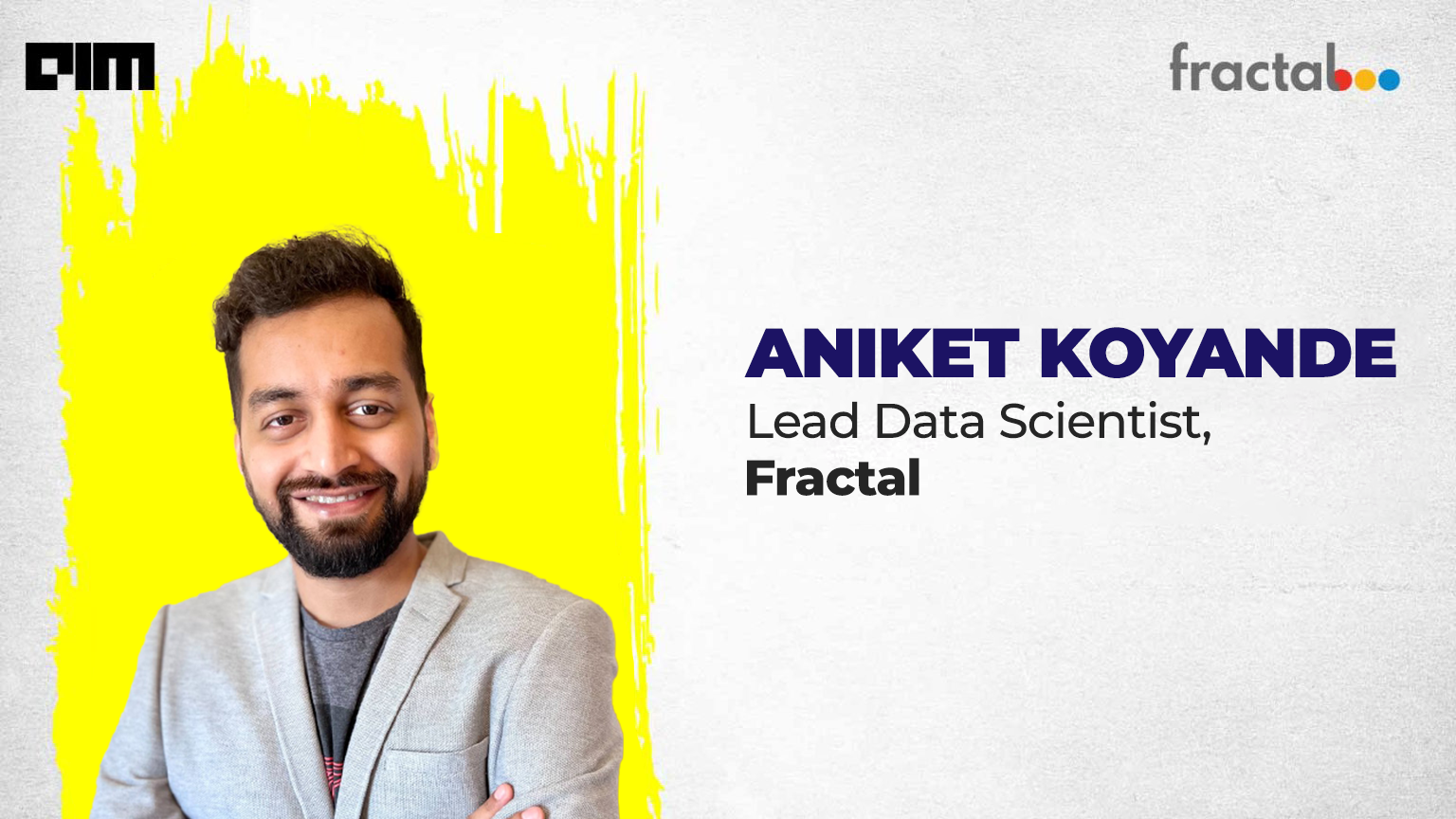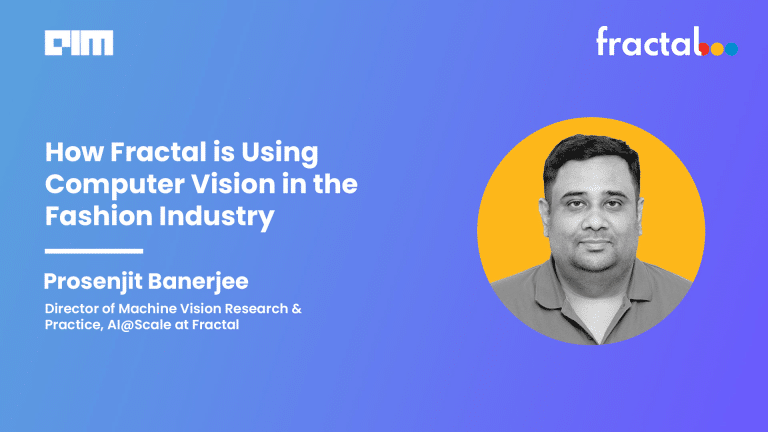|
Listen to this story
|
As the world is going digital, we are seeing more and more digital implementations of customer decisioning and personalisation. Think product/service recommendation, search personalisation, digital marketing, issue identification and resolution, etc. These now have to be real-time, based on the customer’s activity within the web/app session and near-term history and customer attributes. This needs real-time data processing and interventions within the session alongside batch information.
To understand more about real-time personalisation, Analytics India Magazine caught up with Aniket Koyande, Lead Data Scientist at Fractal.
AIM: How did you start your journey in data science?
Aniket Koyande: I have been in the data science industry for eight years; started my career with Fractal in 2014. However, I have pursued my B.Tech.-M.Tech. in Civil Engineering. During my Master’s, my thesis involved a lot of statistical modelling – because of which, I ended up taking courses in probability, statistics and modelling and learnt Python programming. That was my entry into the world of analytics and data science. Many exciting opportunities have come my way since joining Fractal. I started as an Analyst at Fractal, and now I am a Lead Data Scientist here in the AIML practice. My job is to provide leadership from a data science perspective for different client engagements across multiple domains, such as financial services, CPG, insurance, healthcare, etc. Along with that, I am a core team member for Customer Genomics, Fractal’s flagship solution for customer decisioning and Next Best Action.
AIM: What is real-time personalisation?
Aniket Koyande: Personalisation has been around for many years. It started with something as simple as mentioning people’s names in emails. Businesses are then bucketing customers into rule-based segments and contextualising offers they send to different segments. Then came machine learning, which gave marketers a completely new edge by enabling prediction at an individual customer level.
In the last few years, the world has been digitalising at a fast pace; this has been further escalated by the pandemic situation. For example, people are buying more stuff online instead of visiting the stores. Therefore, it becomes imperative for organisations to make sure that they provide the same level of experience on the online channels as they would have done in their physical stores or branches. That is what leads to the need for real-time personalisation. The basic idea is to pick up signals during an active customer session on a website or an application and use them to provide a personalised experience to the customer within the session.
AIM: How did personalisation get a boost with the development and advancement in machine learning?
Aniket Koyande: From the perspective of machine learning, we have models that can learn from any abstract non-linear patterns from the data, which traditional models may not be able to do. The modern deep learning models can identify structured and unstructured data patterns. These models are data-hungry and need a lot of data to learn these intricate patterns, but they are able to do so with minimal intervention.
The second thing is that these architectures also enable incremental learning. This means that one can put these systems almost on autopilot; they can learn incrementally over time and adjust to any changes happening in the data. Apart from the supervised models, there are other neural network models like auto-encoders, W2V etc., which make our life easier by bringing a level of abstraction in case of high-dimensionality problems such as converting a large number of products or web URLs to n-dimensional vector embeddings.
Cloud computing has also been one very important factor that has enabled it; we now have infrastructure that can be scaled up or down on-demand on a huge scale, and this can be done quickly. In the real-time context, compute resources are very important, considering the fact that a company gets a window of only a few seconds to react within the customer session; else, they stand the risk of losing a sale or not providing the right customer experience. Since we talked about using lots of data to train the models, advancements in technology in terms of GPUs have been very important in saving time, especially in the case of deep learning models.
AIM: The amount of data that companies are collecting can be a bit intrusive and could border on infringing on customer privacy. What is your take on this?
Aniket Koyande: There is no straight answer to this. Of course, there is a fine line between being helpful and intrusive. And this is a very subjective topic, meaning different people have different attitudes towards making their data available to companies.
I think there are a few important things that organisations should look for. One is – compliance. We have laws like GDPR and companies and individuals to comply with them.
Thinking from a customer standpoint, most people are not completely aware of how their data is being used and whether it is being shared with third parties. Two things are very important over here. One is awareness from the perspective of customers and transparency from the perspective of organisations (in terms of how the data is being used and how the customers would benefit from them). And the second very important thing alongside this is the consent of the customer, which gives them a sense of control over what information they want to share and what they don’t want to share. Businesses should think of customer data as an ‘asset’ – if they are sharing it with you, it’s fair that you give something back in terms of a great experience or monetary value.
The right combination of AI and human intelligence is necessary because humans understand what is and aren’t sensitive and can add rules and exclusions to override AI recommendations. It is also important how you communicate with the customers to make sure they feel comfortable and not insecure.
AIM: What is real-time next best action?
Aniket Koyande: Next Best Action (NBA) is the process of predicting what is the ideal next action or intervention that a business should make at any point in a customer’s journey. Actions can be related to recommending a product, providing an offer, intervening in case of a risk and so on. Typical NBA models are run in batch mode on a fixed frequency, say daily, weekly, monthly, or ad-hoc basis. On the other hand, Real-time NBA is about identifying the ideal next action at any point in a customer’s active website/app session while the customer is browsing. The intervention can be based on activity within the session (along with near-term history and customer attributes). This is valid for both authenticated and un-authenticated customers.
The most important thing in this context is predicting intent. You may ask questions like – what is the customer actually trying to do? Are they looking for a specific product? Do they need help? Predicting the customer’s intent or need becomes important to be able to take the right action. This requires real-time processing of clickstream data from the customer’s session, converting them to signals for the models, scoring the models, and sending back the right next best action to the webserver to execute. All of this needs to be done within a span of 10-20 seconds. Real-time NBA can include use cases like product/service recommendation, predicting intent and providing assistance, avoiding drop-off, customised offers and content, and search personalisation (for easy navigation). Of course, there could be scenarios where you’re not sure of what the customer is trying to do or if they do not satisfy your criteria for any of these actions. So, no action may be the best possible action in such cases.
AIM: What is Fractal’s Customer Genomics capability?
Aniket Koyande: Customer Genomics is Fractal’s flagship customer analytics and Next Best Action offering. Around 2014-15 we generated $600M in new assets and a 26% sales lift for one of the world’s largest asset managers using our early approach. We have converted this into a capability over time. In addition, we have built a lot of modular accelerators to speed up the implementation of NBX systems for our clients.
The solution philosophy is that you put together every possible signal available on a customer from different data sources and harmonise it. This brings an asset called the Customer 360, which has all the customer information together in one place along with curated statistical and domain-specific signals. Next, we use AI models, which help us generate predictive outcomes, leading to the next best action. Finally, customer response to the action is captured in the system, which forms a feedback loop to incrementally update the model with every new signal. We also have an explainability module to open up black-box deep learning models and understand the drivers behind the decisions.
Customer Genomics has been very useful in marketing, sales, and service – for example, you can churn out campaign lists for different actions in an automated manner, which can be very easily integrated with Salesforce and any CRM tools that organisations may be using. It also empowers companies to get information as to what to do with their customers the next time they interact with them. This has fit very well in both the B2B as well as B2C context. As a result, we have been able to drive incremental value for our clients across a lot of different business domains.
A lot is happening in terms of recent developments. We just recently got a patent for our solution accepted. We also have our Real-time Next Best Action module in development, which should be ready by mid-April which does real-time intervention within a session based on live clickstream and historical customer data. We have also recently partnered with the Behavioural Sciences capability at Fractal to create a point-of-view on integrating some of our proprietary Behavioural Science toolkits with Customer Genomics so that we can understand customers from an emotional standpoint and help them make better and easier decisions.










































